Be honest for a moment…
When publication day rolls around, do you have a post ready? Or do you frantically scramble at the last minute to figure out what you’re going to write?
When you’re writing guest posts for other blogs, are your topics carefully coordinated and strategic, or scattered and inconsistent?
And what about your efforts to fuel the growth of your blog?
Have you tried several different tactics, such as webinars, Periscoping, and Facebook ads only to see lackluster results?
If so, your blog is suffering from randomness.
Fortunately, there is a cure.
The Certain Cure for Blogging Randomness
No matter how good your instincts are as a blogger, real success comes from careful planning, not a series of in-the-moment decisions.
And that means having a content strategy.
It’s the linchpin that makes everything work together. It’s what helps you build momentum to continue to grow over time.
So what exactly is a content strategy?
Demian Farnworth, chief content writer at Copyblogger, defined it this way:
Research from Content Marketing Institute and Marketing Profs shows that those with a documented content strategy consider themselves more effective with their content and social media channels.
But even though the data indicates that a strategy is essential for building a successful blog, the vast majority of bloggers don’t have one. No bueno.
Why Most Bloggers are Allergic to Strategy
Bloggers have an abundance of choices. They have almost no limit to the number of possible tactics that could move the dial on their blog.
But the paradox of choice is that when you have many options available to you, it becomes difficult to choose between them.
Here are a few of the decisions you face when it comes to growing your blog.
First, there’s the medium. Should you only blog? Podcast? Make videos? How about all three?
Then there’s the format. Should your content be long and detailed like the posts here on Smart Blogger? Or should they be short and pithy like Seth Godin’s posts? Or perhaps you should curate the content of others?
And what about frequency? Should you post daily, weekly, or only when you have something truly epic to say?
Then there’s the equally important task of how you drive traffic to your blog.
Here too you have multiple approaches when it comes to figuring out the right plan for you.
The result of having so many options is always the same. You end up paralyzed, anxious, and wasting time.
As a result, your blogging “plan” resembles something like this:
But imagine your results if your plan looked more like this:
When you compare the two, it’s easy to see which approach will likely yield tangible results, and which will leave you floundering in a sea of randomness.
How to Create a Simple but Effective Content Strategy
When I worked my corporate job, our annual business planning was a long, grueling process over the course of four to six weeks. The good news is creating a strategy for your blog doesn’t require the same level of pain.
All you have to do is follow a framework that charts a clear path to get you to your goals.
1) Begin with The End in Mind
In his classic book, The 7 Habits of Highly Effective People, Stephen Covey wrote about the importance of getting clear about where you want to go:
In building your content strategy, your first choice should be deciding on your objective.
Specifically, you have to get clear about why your blog exists, by defining your ultimate goal.
Smart bloggers blog for a definitive specific reason. What’s yours?
Here’s an example:
Next, take this “big prize” that you are working toward, and break it down into specific targets you need to achieve to grow your blog along the way. This will help to guide the strategy you create for your content.
Your milestones will vary depending on where you are in your blogging journey. Here are some common ones:
- Build an engaged and loyal fan base who share and comment on your posts
- Reach your first 1,000 email subscribers
- Consistently earn $5k/month
Your strategy may need to adapt as you hit each important milestone, so it’s a good idea to revisit your content plan after you hit each one.
2) Get to Know Your Audience Inside and Out
Every decision with your blog must begin with your readers. You’ve got to consider their likes, dislikes, and needs, as well as their dreams, desires, fears, and frustrations.
If you’re tempted to ignore this step, assuming you know everything there is to know about your audience, don’t. This is the glue that makes everything work.
Some common, helpful advice for getting to know your ideal readers well is to develop personas. Here’s how blog and business writing coach Henneke describes the relationship you should have with your ideal reader:
When describing your ideal reader, don’t just think about demographics like age, gender, income, education, and family circumstances. Do you know what he dreams of achieving? And what keeps her awake at 3am?”
(To find out more about getting to know your readers better than they know themselves, go here, here, and here.)
Once you’ve got a strong handle on who your audience is, you can use that information to guide your content strategy.
3) Design Your Content Conveyor Belt
Your content plan will serve as a “conveyor belt” to help you move your audience along the various steps in the journey that leads you both to your goals.
Here are the typical stages you need to move your audience through:
To effectively move your readers from phase to phase, use the knowledge uncovered in the previous stage to answer the following question:
Because when you think about everything you publish not simply as “content” but as a catalyst for a specific change, your approach to blogging will shift.
Great content transforms your readers. And that transformation should progress both you and your audience toward your respective goals. That’s why every piece of content you publish needs to have a purpose.
To induce this change, you need to know what issues are dominating your readers’ thoughts, as well as what they need to move to the next step with you. This will help you determine what type of content to give them.
Matching the right content to where your audience is on their journey with you is critical to helping you get results.
Here’s an example of what types of content works for the various stages:
And here’s an example of that playing out in the real world.
In this guest post on The Change Blog, international best-selling author Stephen Guise uniquely addressed a common burning pain of his ideal reader: getting in shape. As a result, he was able to turn thousands of strangers into readers.
By offering a free chapter of his book on mini-habits, the strategy he wrote about in his guest post, Stephen was able to convert a good number of those new readers into subscribers for his blog.
Every Tuesday morning when he sends an email to his list, he works to turn those subscribers into loyal fans by continuing to address topics that interest them.
And some of those fans become customers whenever he releases a new book or reminds them of other books and courses he has available that are in line with their needs.
4) Determine the Optimal Format for Your Content
When deciding what content to give your audience, you’ll also have to determine the best format.
There are basic choices such as the medium: i.e., text, audio, or video. But there are tons of other considerations too, including length, use of images, and even if your blog post should be a listicle, case study, or tear jerker.
Before you get overwhelmed, take comfort in knowing there’s a simple way to discover which choices are ideal to help you grow your blog.
Let the data decide for you.
Mining the comments you’ve received on content you’ve already published can give you clues about what your audience is most receptive to.
Andrew Warner at Content Ranked publishes long-form posts. Based upon the gleeful comments he received, his audience is hungry for more content with the same level of detail.
You could also ask your audience what their preferences are. In this post, Linda Formicelli used a simple survey to figure out if her audience wanted her to branch out into audio and video content.
And in this case study, Andrianes Pinantoan, detailed how Canva used 3rd party data to figure out the ideal post length, type (list post), and even the number of images they should include in every article.
By doing research on their competitors’ most popular posts, using forums to identify new ways to tackle common issues, and capturing insights on what their readers were already sharing, they were able to create a profile of the form their content needed to take if they wanted to grow.
5) Choose the Right Channel for Your Content
As with the format, the objective of each piece of content plays a role in channel selection. If your goal is engagement with your audience, then publishing on your blog or sending an email to your subscribers is the way to go.
If you are trying to reach a new audience, you’ll need to select a channel that lives outside your blog.
Here’s a way to think of which channels are most appropriate for each stage your audience goes through.
Srini Rao, host of the Unmistakeable Creative podcast, publishes blog posts on Medium as a way to get new listeners.
Because creating great content can be so time-consuming, consider publishing different elements into different channels to get as much traction as possible out of the core pieces you produce.
Gary Vaynerchuk swears by this repurposing strategy. From his core content pillars of The #AskGaryVee and Daily Vee shows, he and his team make several pieces of content reach different audiences in different places.
Jay Baer of Convince and Convert does this as well. Three times a week, Jay publishes a three-minute Jay Today video. And each video becomes eight different pieces of content. It’s part of what they call their “atomizing” strategy.
6) Build Relationships with Regular Communications
Have you ever met someone, hit it off brilliantly, then failed to stay in contact afterward?
That relationship would have had a chance to develop if one of you had been more intentional about keeping it going.
In growing your blog, you can’t expect your audience to actively build the relationship. It’s up to you to provide consistent communication to maintain the connection with your audience.
The key is to set expectations so they know when to expect to hear from you.
Ben Settle emails his subscribers daily and is very clear in making sure that people considering signing up to his list are aware of how often he will show up in their inbox.
Even if daily contact seems too much (and it probably will be for most bloggers and audiences), it makes sense to email your subscribers more frequently in the beginning.
Many smart bloggers will automatically add new subscribers to a short welcome sequence before falling into a regular schedule of sending their latest blog content.
Brian Clark sends new subscribers to his Unemployable list a series of three emails as a part of a mini-course, and then transitions into weekly emails.
Once into your normal publishing schedule, the ideal frequency for you and your audience will be determined by a variety of factors, including their preferences, and how much time you need to produce quality content.
Your aim should be to email often enough so that your audience remembers you and is happy to hear from you, but not so much that they are overwhelmed with all your messages.
Danny Iny and his team at Mirasee email their audience six days a week. But for those in their audience who feel like six messages are too much, they give them the option to receive fewer messages.
And if you’re unsure about what the right frequency is for you, err on the side of publishing less often, and make sure that when you do post, it is the best content you can possibly write on the topic.
Here’s Jon Morrow’s take on this issue:
7) Pick the Perfect Promotion Strategy for Your Content
Another major consideration is how you will get people beyond your subscribers to see your published content.
There are six common ways to do that – you can use one approach or some combination, but each has its pros and cons.
Paid Traffic
If you’ve got money to invest, this can consistently bring qualified leads to your blog. Facebook Ads can be complex to setup but very successful once up and running.
SEO
If your content ranks for a relevant term, it can bring a steady stream of traffic from people searching for the topic you write about.
Danny Margulies at Freelance to Win writes about how to make money on Upwork, and he gets plenty of search traffic because he ranks #1 for this term.
However, be careful about selecting SEO as your primary traffic generation strategy, especially as a beginner. Despite the obvious appeal of search traffic, it’s not the best approach for everyone. But that doesn’t mean you should ignore it altogether.
Here’s more Jon Morrow advice for effectively incorporating SEO into your content strategy:
Influencer Outreach
If you know how to build relationships and connect with influencers, having them share your work is a great way to get introduced to new audiences.
Borrowed Audience
Publishing your content on sites or platforms with significant built-in audiences is a popular way to get more visibility for what you produce. Two common approaches for this strategy are writing guest posts and contributing to 3rd party sites like Slideshare.
Email Subscribers
When you have a critical mass of people in your audience, who are also sharers, they can serve as a valuable army, quickly disseminating the word about your content.
Here’s how Smart Blogger encourages their engaged readers to share their posts:
Social Media
Social platforms are designed for sharing and connecting. If you establish a following where your audience hangs out, it can be an excellent way to reach new people and get them back to your blog.
About Meditation uses Instagram to find new readers. Here’s how they strategically use individual posts to get people back to their website:
Here’s the post:
Here’s the call-to-action:
And here’s the link in the bio that leads readers to a landing page on their website:
8) Close the Deal with a Call-to-Action that Converts
The last component of your content strategy often seems like a minor detail, but not giving proper attention to this essential element can mean the difference between reaching your goals or not.
It’s all about conversion. Specifically, the content elements that make it clear what next action you want your audience to take, and making it easy for them to do so.
For instance, let’s say your ideal reader comes across a piece of your content on Twitter. They get to your website, read the content, and love it. Once they’re done, they say “that was great” and off they go, never to be seen again.
You did all the hard work to get your ideal reader to your site, but you didn’t have content in place to close the deal. Shame.
To prevent this unfortunate occurrence, make decisions in advance about what specific content you need to convert your audience to the next step in your continuum.
Here are some examples of the conversion choices you could make in each of your audience stages.
Here’s how Happify uses relevant hashtags to increase discoverability on Instagram.
To turn readers into subscribers, Primility uses an exit intent pop-up box that appears after someone finishes reading a blog post.
To turn subscribers into loyal fans, Marie Forleo encourages her audience to leave comments on her videos and gives explicit instructions on how to do it.
And to help convert loyal and engaged fans into customers, I include a money-back guarantee on my coaching sales page.
In each instance, the bloggers make it clear and easy for their audience to take the next desired step.
Reject Randomness and Create a Simple Content Strategy
It’s time to admit it.
You invest too much time and energy in your blog to accept a ho-hum response.
But the truth is, randomness is killing your chances of success.
Without a coherent strategy for turning strangers into subscribers (and maybe even customers too), you’ll burn out before reaching your destination.
You don’t have to create a complicated plan—you just need to work out what content will move people from one stage to the next.
So, start a blog using a simple content strategy and see how it gets real results.
Your blog deserves it.
Your audience deserves it.
And you sure as heck deserve it too.

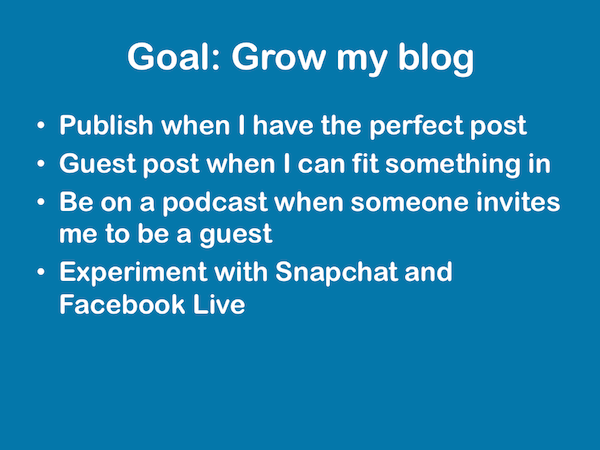
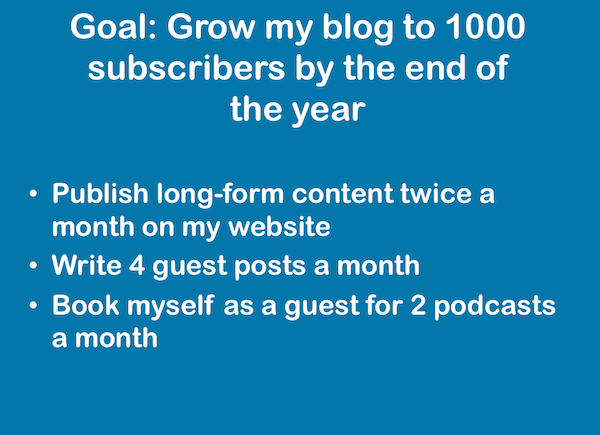
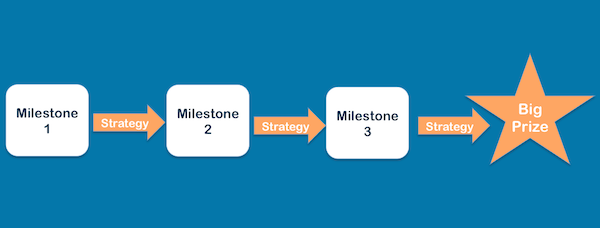
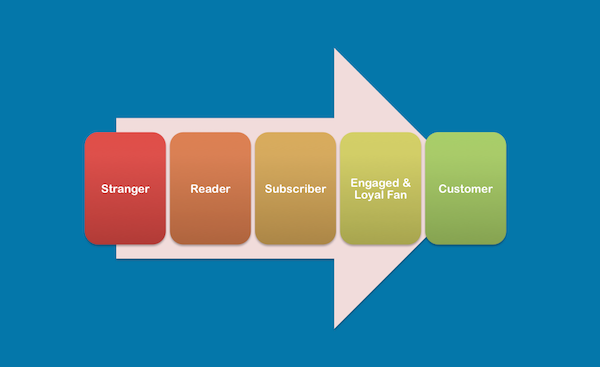
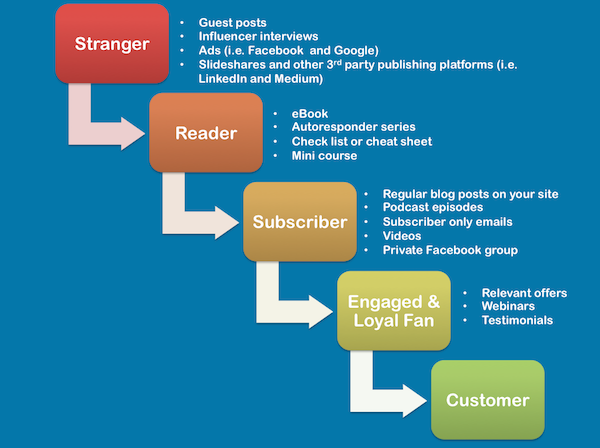
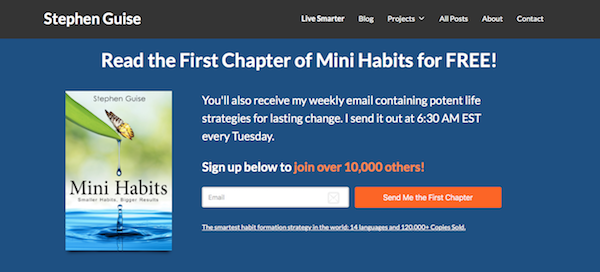

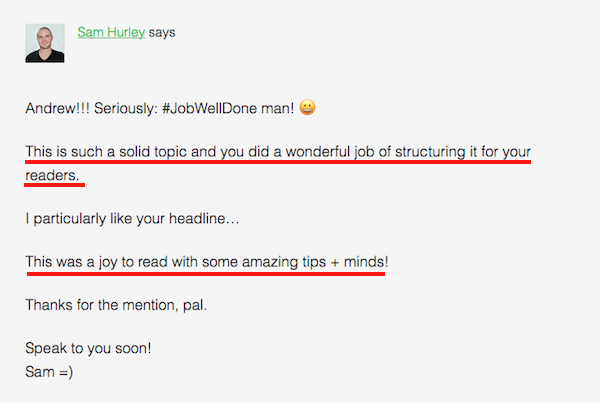
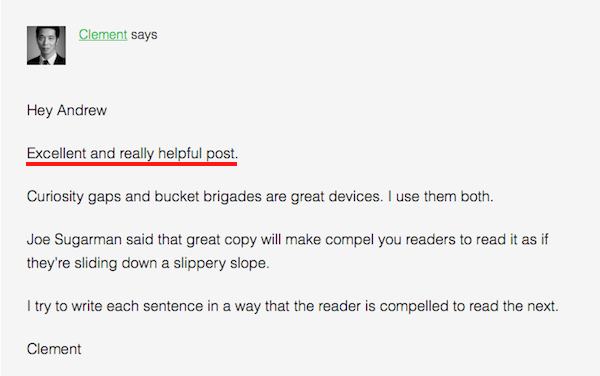
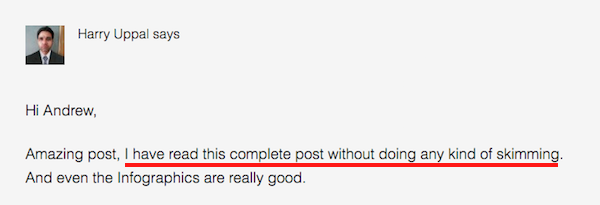
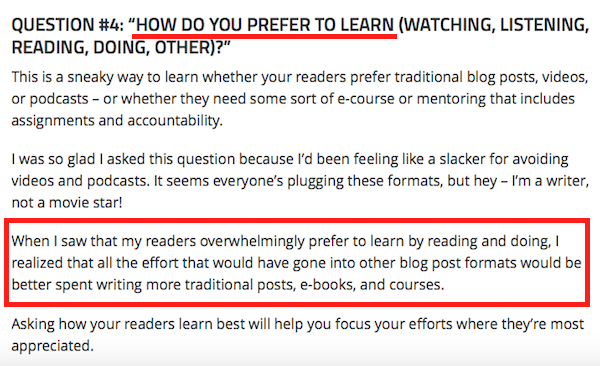
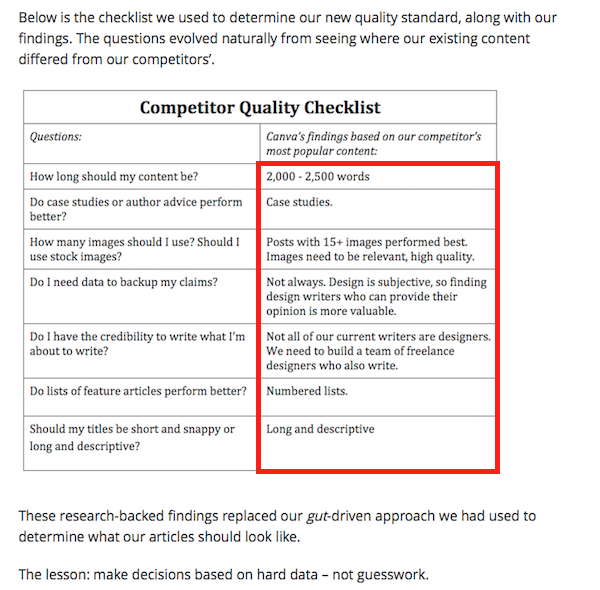
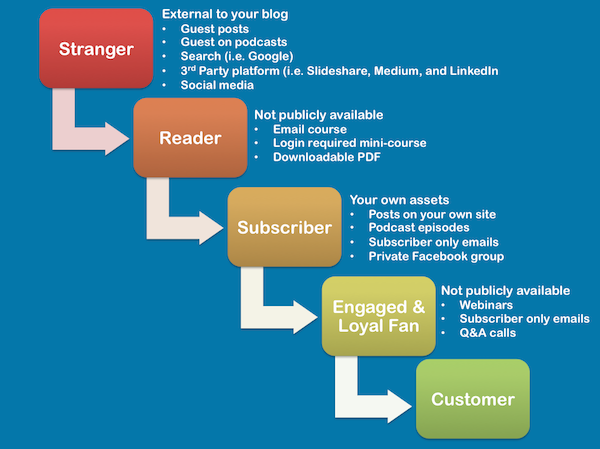
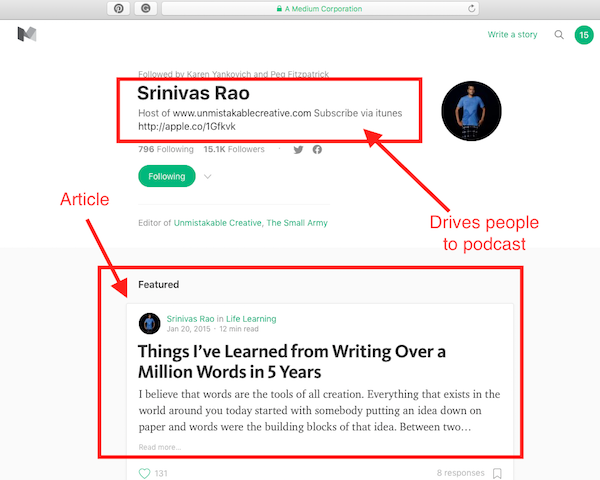
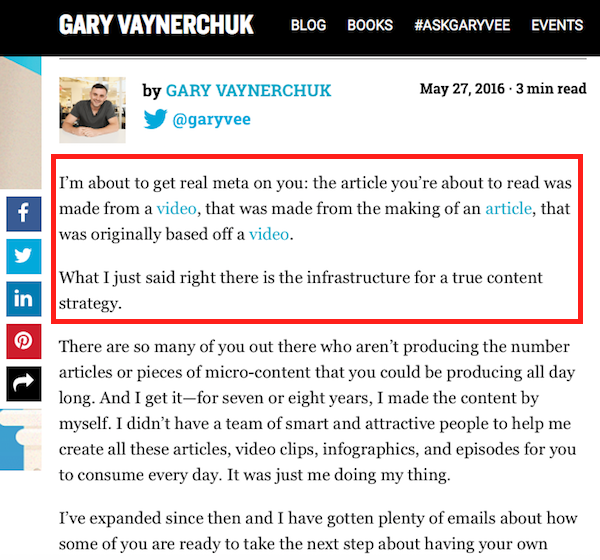
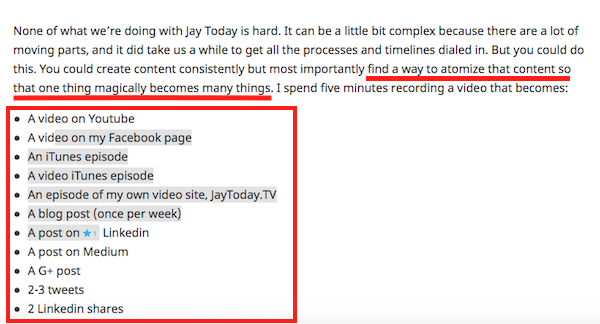
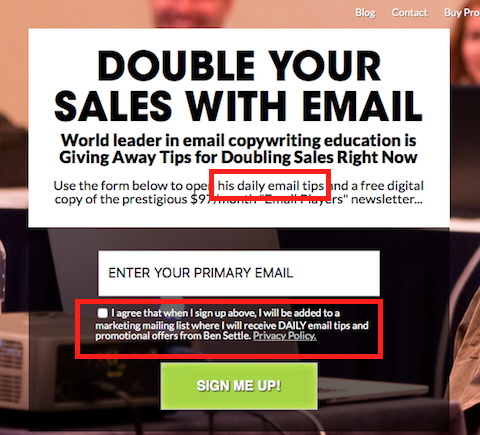
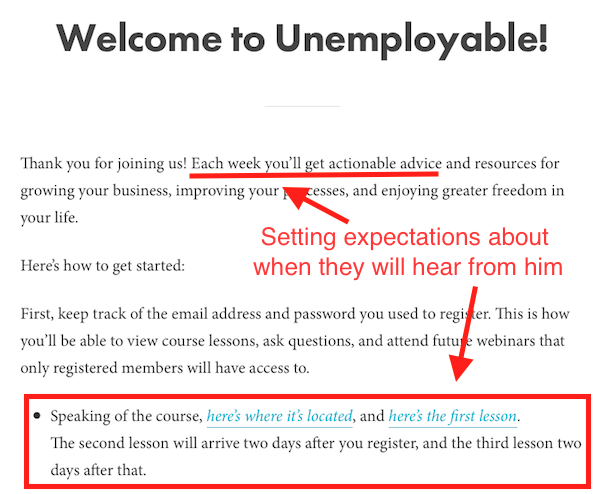
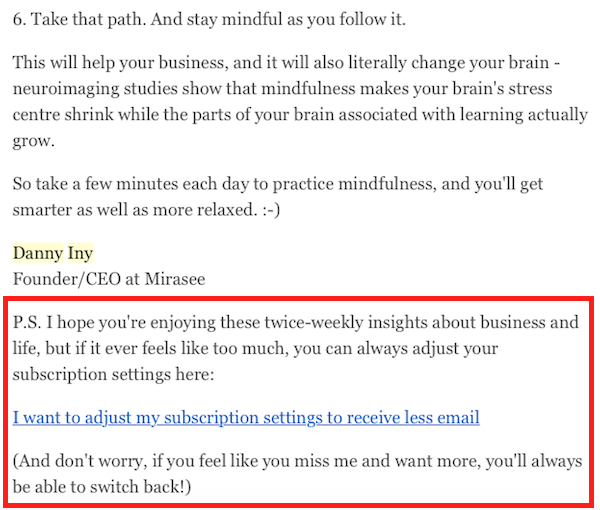

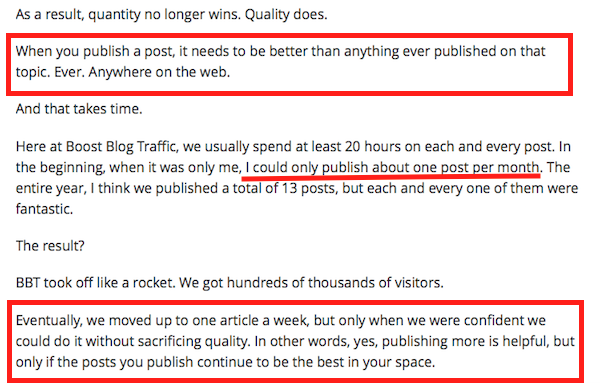
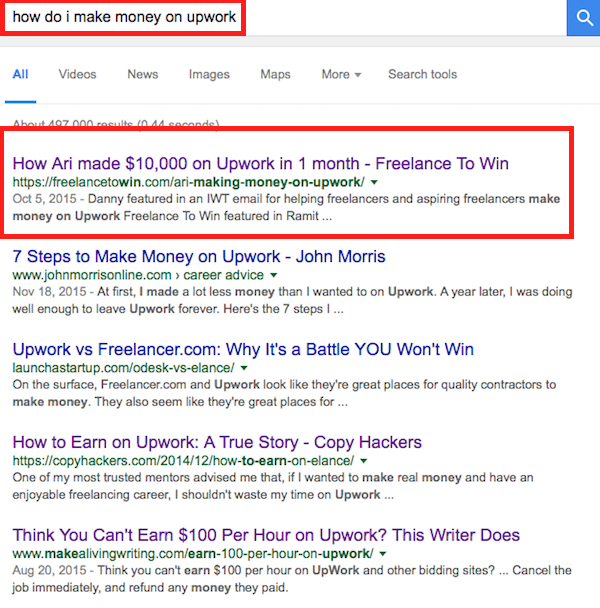
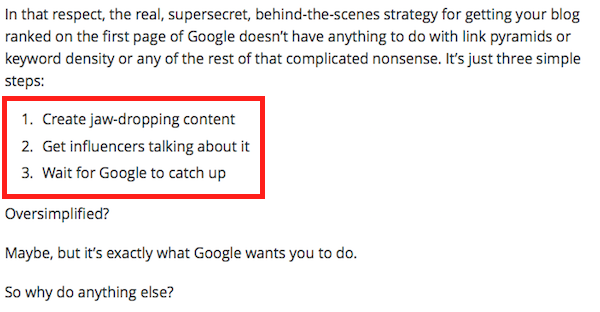

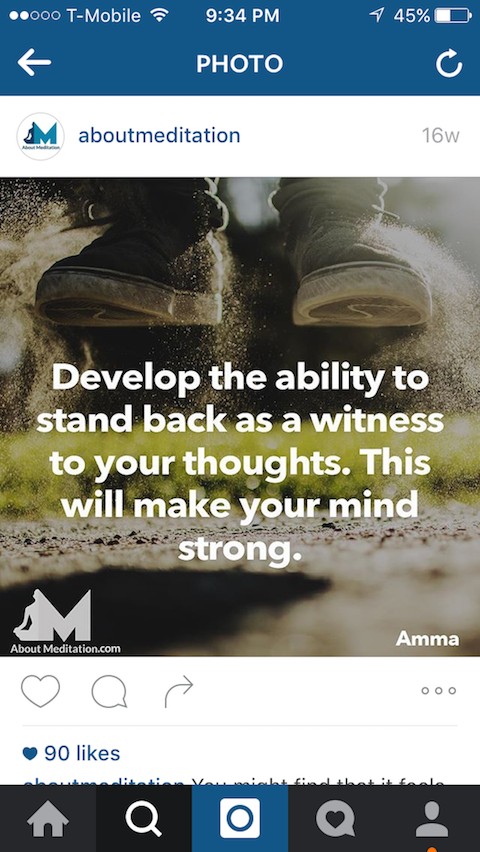
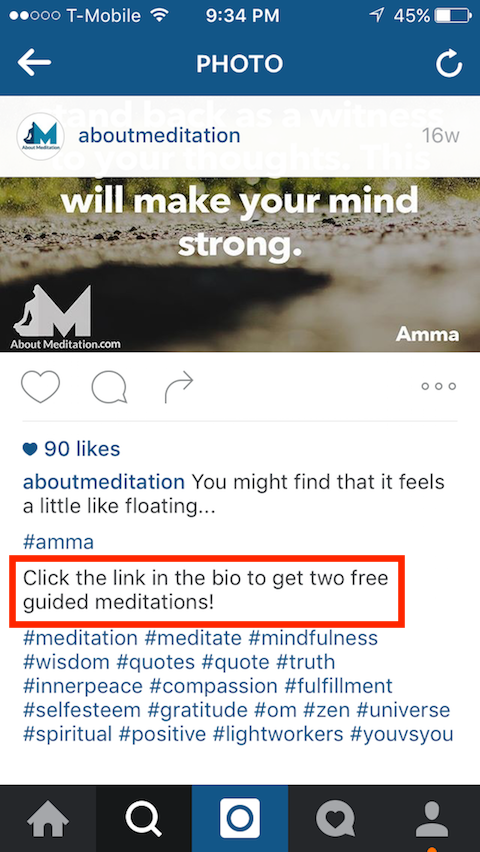
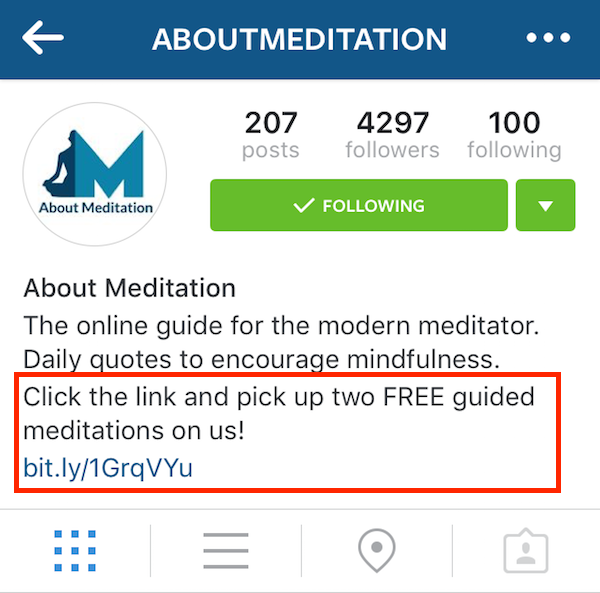
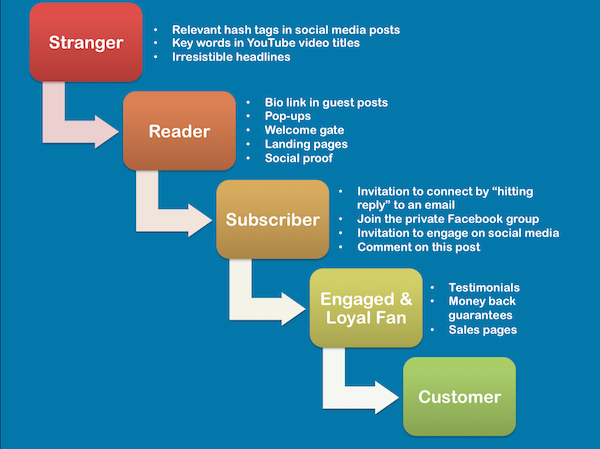
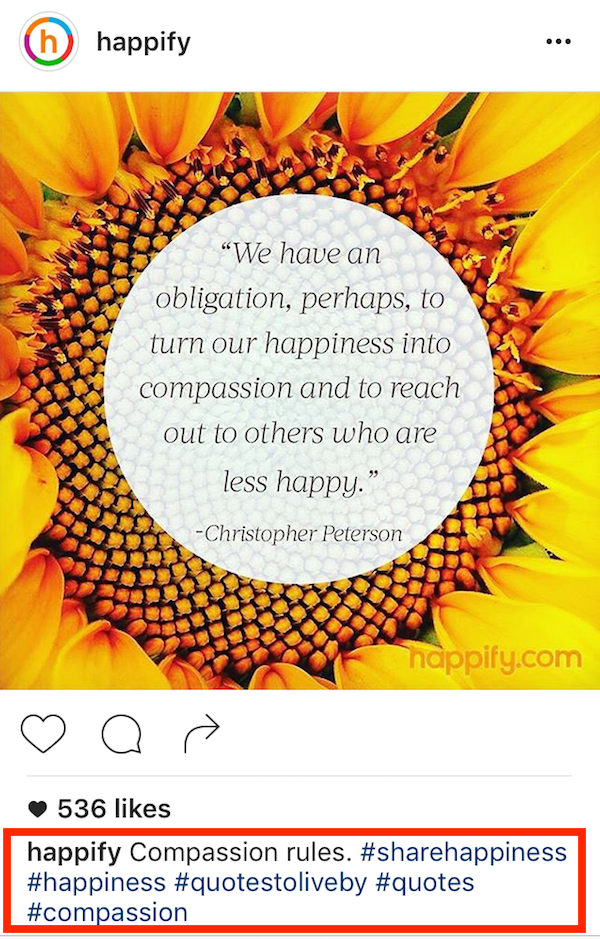
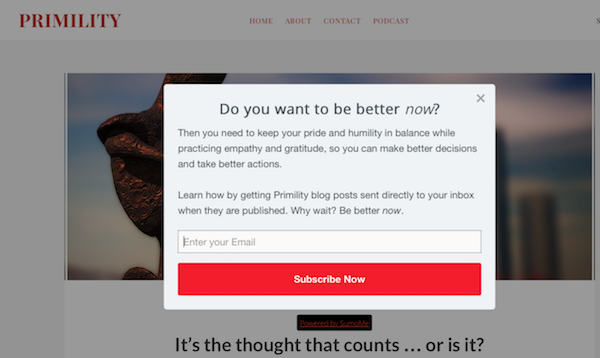
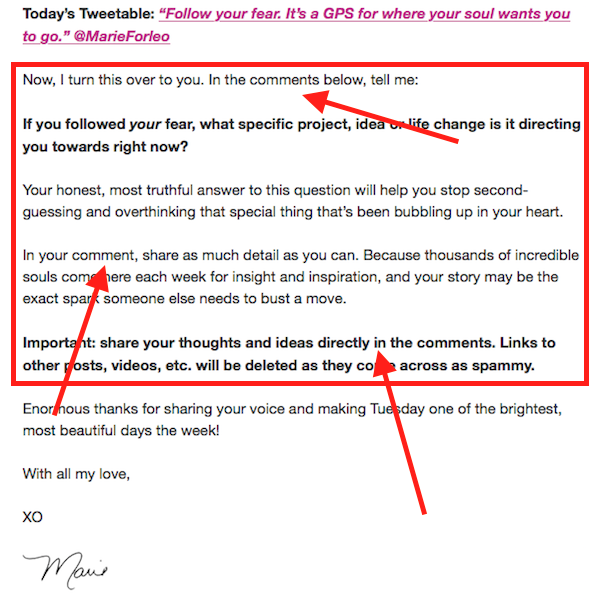
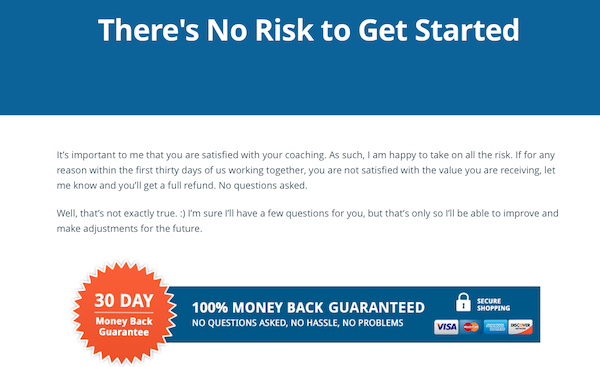
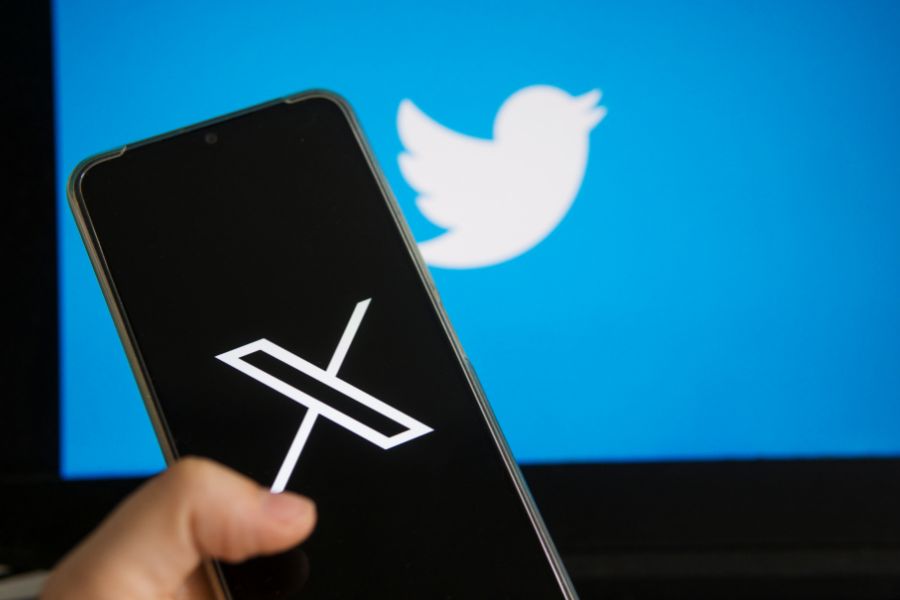
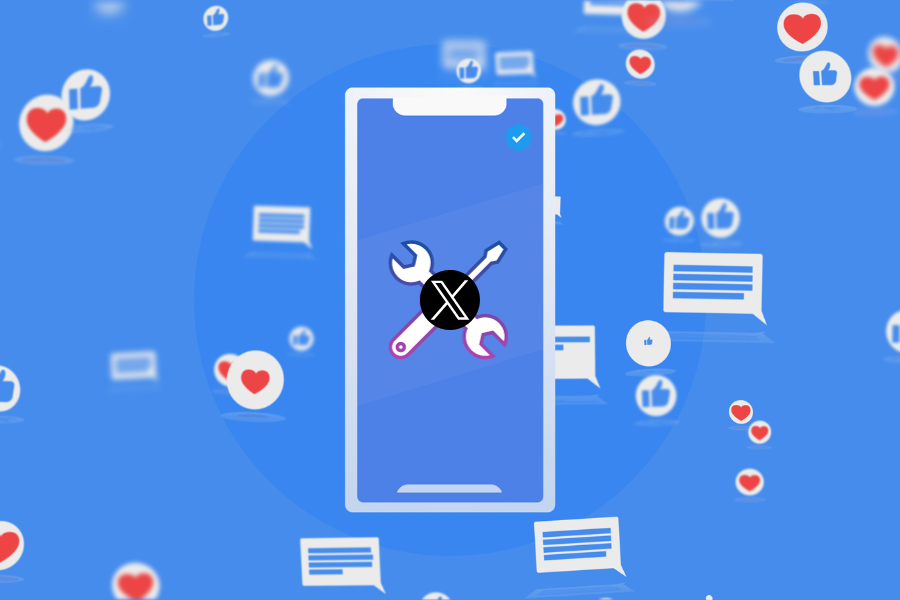


Thanks for this post… the post is comprehensive enough to be a traffic guide. Though most of the things stated here are strategies on their own, and are so broad to implement and be successful.
Having the end in mind could be useful though, but could also make someone to be aggressive and self centered. For instance, having a targeted email subscribers at the end of the year, you make you forget yourself promoting your email list, while you supposed to be producing great content.
Facebook ads to me, is cool, but the reach in recent time is not encouraging…
Reaching out to influencers is one of the strategies I used over time, and has been wonderful experience growing with them.
Thanks.
Hey Uthman – thanks so much for stopping by with your comment.
Beginning with the end in mind is definitely a great place to start. The objective of defining your goal is to put you on the right path, and to help you with focusing on doing the things necessary to achieve it.
But – that doesn’t mean to neglect the other things that are important to helping you reach the goal. Make sense?
Glad you’ve found an approach that seems to be working for you – keep it up! 🙂
Getting more traffic means people living in their emotional comfort zones have to change something. And that something is write more content and spend more time working. And a 2nd thing is sharing that content on social networks. More than 1. If ppl could change their mindset they could change their blog income and accelerate traffic potential.
Hey DNN – often when we’re trying to achieve something important, it requires us to step outside our comfort zones. It’s what will help us to stretch and grow :).
And for many of us – it’s what will help us get results with our blogs.
This is very true Sonia. When we feel uneasy and discontent, that’s when we grow. Not when things are good.
Sonia, your article has resonated with me – a nearly 2-year old blogger. I have been a victim of randomness. Never wrote down a simple content marketing plan and let the things to flow. Only to realise that if you don’t write it down, it can take painfully long to achieve an objective.
Recently started the habit of writing things down and have already started seeing the results. It just becomes your habit and you feel psychologically content that you are heading for a definite objective. Thanks again for a nice article.
Hey Ahmad – many of us are guilty of randomness at some point. The great news is that you are starting to document your plans, and it has made a positive difference.
Keep going!
Hi, Sonia!
I haven’t read anything better on developing a content strategy than this. I’m literally happy after reading this. It was actually very simple yet effective (as promised). Hats off!
I have been a victim of this. In fact, I see most of the bloggers even they’re making money from their certain affiliate sales, but the way they’ve mixed up their content strategy with a bundle of things, it starts looking more like a collage than a plan.
What I suggest to all readers of this post is that, take away a simple understanding of content strategy that how to make a coherent and parallel content marketing plan for your blog/brand. You’ll be fine.
Thanks again, Sonia!
Stay Blessed.
Hassan – thanks so much for your kind words!
You’re right – we all need a plan, and a simple one will work just fine, to help us achieve the goals we’ve set for ourselves.
Thanks again Hassan, and all the best to you as you implement your strategy for your blog. 🙂
Thank you, Sonia, for this thorough article that is absolutely helpful for me RIGHT NOW! I was just scrambling last night to get a post together. It will be a helpful article I hope, but definitely not part of a strategy or plan for my readers.
I’ll read this article a few more times and concentrate on my next steps. Thanks for the time you took to create this. 🙂
Thanks so much Mica! I’m sure your post will be helpful – and now you can start putting all the pieces together to put a plan in place that helps both you AND your readers. 🙂
Thanks so much for stopping by with your comment
Ooh, loved this post Sonia! I’m totally guilty of blog randomness from going after too many different options. Your graphics about the comparison on blogging goals is spot on!
Thanks for sharing this – downloaded your content strategy course & looking forward to working through it.
So glad you found this useful Candis! I think most bloggers are guilty of randomness at some point in the journey. Here’s to getting focused with your efforts! 🙂
Candis,
DNN is guilty right along with you. They key to success in blogging is to keep going even when you’re unsure. You were experimenting simply with what works and what doesn’t. What works for you will work itself out completely. Hang in there. 🙂
Great Post Sonia,
This article worth a lot for the bloggers like me. I’m blogging from last 2 years and my blog was getting a decent traffic. But still, it’s not having the things as I wanted (only few hundred’s) . As your post also indicate content marketing is the best way to achieve our targets in blogging. Now I can try some other options for growing my blog traffic and increase subscribers.
Jitender – so glad you found the post helpful. All the best to you on creating your strategy to grow your blog. 🙂
Hey Sonia!
I started a new blog at the beginning of this year, and I’m currently working on improving my content strategy.
What perfect timing!
Breaking things down into stages is extremely helpful, thanks for that.
I feel like you wrote this just for me.
I’m constantly struggling with what formats and channels to use for my content.
Thanks for all the awesome tips.
I’m excited to apply everything I’ve learned.
Hey Eli – I love it when serendipity happens like that! Please do keep me posted with how you progress with working out your strategy, and feel free to reach out with any questions. 🙂
I have just started a campaign with paid traffic and my alexa rank is boosting..
Awesome Raphael – so glad the strategy you’ve chosen is working for you 🙂
Glad it’s working well for you Raphael 🙂
Sonia,
That’s a content filled post!
My to-do-list -Send a Question to my subscribers and ask them how they prefer to learn …I never thought of that. I gave them what I assumed they wanted…Now I know.
Hey Ann! That sounds like a great plan. The data rarely steers us wrong, so the more we get in the habit of using data to make our decisions, the better off we’ll be.
Thanks for stopping by with your comment 🙂
Great post, Sonia. I love all the examples and also the custom graphics you added to this post!
I like your suggestion of creating a content strategy, but keeping it simple. There’s a lot of activities we could do, but we have to be careful not to spread ourselves too thinly as we might not achieve anything if we try to do too much.
Thanks Henneke!
Yes – overwhelmed is not the feeling we want people to have, especially with so many options out there available to you. So simplicity is definitely the way to go if we want to move forward.
Thanks so much for stopping by, and for always providing such a great example for us to follow! 🙂
Hey Sonia,
That was a really great, information packed post.
There’s so much to learn and absorb from this I don’t know where to start.
Your process to create a content strategy is very well done. That’s something that simple but would seem very effective.
I’ll admit that I struggle with communicating with readers/subscribers in emails. That’s because I had zero autoresponder before and had nothing in place to guide them through to what my ultimate goal was. But I’m really working on it. While I’m not publishing as much content, I’m spending time creating email content and at least being strategic with it.
I never considered how my readers or subscribers would prefer to learn but I have been repurposing my content more. So rather than just text, I try to do infographic a and slideshare. I need to try audio again but I think rather than ‘waste’ my time, I’ll just ask. At least I know the majority likes meaty content lol.
Thanks for putting together this great post and thanks for the mention. Congrats on getting onto smart blogger again and this post was definitely one of the best I’ve read.
Have a great weekend and holiday.
– Andrew
Thanks so much for your kind words Andrew – so glad you enjoyed the post.
Sounds like you’re getting yourself on the right track – since you know where you’ve struggled in the past. Knowing where you need to improve is a big leap forward. And I’m sure now that you’re putting attention to the what and the why of your content, you’ll start to results you can be pleased with.
Your content really is great by the way – it shows that you invest a ton of time in creating it. 🙂
Thanks for stopping by!
Sonia,
I just got your 5-part mini course through email. Thank you! My blog is all over the place and full of randomness! OUCH. I also don’t know the answer to “Why your blog exist.” GOSH. I will be doing your Content Strategy blog checklist and really hoping that it will help. There are also so many useful links here so I have bookmarked this post and all the links too. I really love Andrew Miller’s content strategy. All these are really overwhelming but I’ll definitely update you about my process through your blog.
Many thanks again, Sonia.
Hey Ada – glad you found the post useful.
Please do keep me updated with how you progress, especially after going through the course and checklist.
And as you work to figure out why your blog exists, spend some time thinking about why you started it in the first place. Was it just because you wanted to share your thoughts? Did you want to use it to build your business? Did you want to bring awareness to a particular issue?
There are many reasons, but going back to the beginning and evaluating why you started, and thinking about what your overarching dreams are will help you narrow it down. Hope that’s helpful! 🙂
Hey Sonia
This is a great information to make task easier for any blogger. Having a simple content strategy definitely helps you save lots of time.
Thanks so much Rajkaran – the content strategy definitely will save you time in the long run, by helping to streamline your efforts. 🙂
Great post Sonia! I totally agree that bloggers should have a well-planned content strategy. It also important that they set a goal for their blogging journey from the start so they could also identify the steps to achieve that goal.
Thanks George – beginning with the end in mind is super important in all we do 🙂
Really well researched and nice post Sonia.
Glad you enjoyed it Vinodh – all the best to you
Hi Sonia,
This really hits home with me. Now I have a term for my strategy, “randomness” . when I started reading, I thought this will be another “how to manage your blog” effectively. But you have given an strategy that could really catapult a blogger to the success he is wanting. Thanks for this.
Bhuboy – so glad you were able to identify what your issue is. Wishing you all the best as you ditch randomness and achieve the success you desire with your blog 🙂
Great advice, Sonia. Love the part about having specific goals and really knowing your audience. Can’t be reminded of this enough. Thanks so much.
Thanks Laurie – yeah, those are foundational concepts. And because they are so important, it’s always a good idea to revisit them often to make sure we’ve got everything in order 🙂
I also tried paid traffic campaign and yes it does help in alexa
Hey Ajay – glad you’ve found an approach that works for you!
Hi Sonia,
This is an incredibly useful, awesome post. I read it this morning while enjoying a cup of coffee and my first morning in Thailand:)
I love the way you related the content strategy to the stages that an audience goes through as they discover your blog and become customers.
Often I simply focus on getting people to become subscribers, via guest posting, then don’t focus enough on my on blog where I engage and get to know them.
And the real-life examples are super helpful for putting these into context.
jessica
Oh, one question. What does a content strategy actually look like for you? A word doc where you break down strategy by each of the stages?
A Word Doc works, or a PPT. It can be as simple as the one of the first image in the post where you say for instance:
Blog Goal: XYZ
1. Approach
2. Approach
3. Approach
4. Approach
And those elements that help you reach your blog goal can help you address each of the stages. Does that make sense?
I’ve got my strategy written down in a notebook – so the format isn’t as much as important as making sure that you document it.
Hey Jessica – so great to see you here! And I’m slightly jealous – would love to be in Thailand sipping some tea – sounds divine 🙂
What you described is a common challenge – it can be difficult to divert your attention to making sure you nurture customers through different phases. But having the documented strategy that addresses each stage can definitely help you with that.
Yes, understanding our audience inside out is one of the best blogging success strategies as this will help us to satisfy their their need
Absolutely! As Jon Morrow has said – “the blogger who understands his audience the best wins.”
This is a fantastic post.
I am definitely going to share it on my Twitter.
I am slightly OCD and content plan like a beast, I just find it really hard to guest post or be on podcasts…. I feel like I’m not letting myself get out there effectively.
How can I do this?
Thanks Krysten – so glad you enjoyed it! And many thanks for sharing 🙂
What is it about guest posting or being on podcasts that you find so hard?
If neither of these are strategies that fit with your personality, there are other options, such as paid traffic, or focusing heavily on being ranked well in SEO.
It’s key to find a traffic and growth strategy that work well with your personality – that will help it to be more sustainable for you. 🙂
Sonia,
Thanks so much for this article. You inspired me to get away from quantity and focus on quality content.
Never had a real strategy and it is starting to show in the results (read no results). Ready to take some action.
Hey Esther – so glad you enjoyed it!
It is a big decision to move away from posting more frequently, especially if you’re in a rhythm.
But if you’re able to produce much more authoritative content, it can be totally worth it for you, and can really help you start seeing results.
Keep going, and please do keep me posted on how you progress. 🙂
Thanks so much! 🙂
Dear Sonia,
What a fantastic article! Giving yourself permission to slow down is a wonderful idea, and one that I will be following from now on.
I have to admit that it does feel like I am running around like a headless chicken at times, but with your idea of planning every stage and knowing what you are going to write next and for whom has instantaneously allowed me to be free.
I can now see a glimmer of light at the end of what was a very dark and very crowded tunnel.
The more I work, the more snapshots of light I see.
Best wishes
Hey Jennifer – so glad you found value in the post!
And I’m so glad you’re giving yourself space to breathe a bit. I think you’ll find you’ll be able to create more impactful content when you don’t have a ton of pressure on you to just get something out.
So glad you’re able to see that there is a way out of that tunnel – you can break through.
Keep going, and please do keep me posted on your progress. 🙂
You have simply done a great job. When I sarted reading your post, I didn’t understand what you meant to say.
But after giving a read twice i understood the whole thing .
Thanks for sharing.
Hey Ravi – so glad it clicked for you the second time around 🙂
All the best to you and your blog!
Loved the content and the images to support it in this article.
Question: You say you should begin with the end goal in mind for your blog, but is that goal 1, 5, or 10+ years down the road? Or does it depend on the individual?
Hey Brian – so glad you enjoyed the post! 🙂
The big goal here I’m referring to is the big picture “prize” that you’re striving to achieve with your blog. So in all reality, that could be 5 to 10 years out.
Having your end goal in mind will help you keep it at the forefront of your mind.
But, then you should break that big picture goal down into smaller milestones. This will help keep you focused on more short-term goals along the way to keep you motivated, and on track.
Those short-term goals could take you anywhere from 3 to 6 months or even a year.
Does that make sense?
It may depend on the person. However, if you plan on making blogging and affiliate marketing your definitive career, it’s a good practice to have a 10 year vision intact. Right, Sonia?
Thank you for the wealth of information. I will put into action two recommendations for now. Your post offered encouragement to “keep on keeping on!”
Hey Rosie – so glad you got value out of this post. Which two recommendations will you be implementing?
Keep going for sure! 🙂
Thanks so much for this amazing post Sonia. As a professional online marketer I know the importance of a content strategy but somehow I hadn’t brought it over to my personal blog.
I started it in February and it has gone well but in the last week or so I have been lost and jumping from one random thing to another without getting anything really important done.
I have written down my end objective and important milestones already and my content strategy is coming together thanks to you. Cheers!
Hey Caleb – sometimes it’s super difficult to do the things we do so easily for other people, to the work we do for ourselves.
I’m super happy to hear that your content strategy is coming together, and putting an end to some of that randomness you’ve been experiencing.
Thanks so much for stopping by to comment, and please do keep me posted on your progress. 🙂
Hi Sonia,
Thank you so much for this awesome post! I have been guilty of trying to achieve things in a random manner. I started sticking to a plan since last year. Even though I still do a a lot of unplanned stuff, it is better than before. I am definitely sticking going to try and stick to my plans better.
Hey Anirban – congrats on the progress you are making!
Some planning is better than no planning – so keep going, and you’ll get better at in time. 🙂
Awesome tips of content marketing. will use in my next plan. thank your for sharing actionable tips.
My pleasure – so glad you enjoyed it! 🙂
Hi
Sonia i really like this post Sonia! I’m totally guilty of blog randomness from going after too many different options. Your graphics about the comparison on blogging goals is spot on!
Hey Sara – so glad you got value out of the post! So many of us have been guilty of randomness a time or two. 🙂
Hi Sonia,
I really liked this post! I liked it so much I had to book mark it specifically so I can go back to refer to it while i’m implementing some of the strategies you have.
Coincidentally, I am currently listening to the audiobook “The 7 Habits of Highly Effective People” by Stephen Covey.
I am in the beginning stages of building my blog, and I was setting goals haphazardly without a direct plan. There is so much to do when first starting a blog, and I know it will all take time.
However, I am going to begin with the end in mind and work backwards. This post has given me motivation to set a goal and appear on podcasts and write guest posts.
Thanks for an amazing article!
Hey Corey – I’m so glad you enjoyed it.
Beginning with the end in mind takes a bit of time up front, but it works like a charm when it comes to getting clarity on how to proceed. All the best to you! 🙂
Hey Sonia,
Yes, I know how it is to be everywhere with your content and not going anywhere. When this happens, you have to slow down and focus on the content that your audience and subscribers resonate the best to.
You also want to keep the communication going to get to know your audience. There are going to be some things that your audience will like and other things that will give them a reason to unsubscribe from your email list. You want to be mindful of how frequent to email them as well as figuring out how much time you have to produce content that will be of value to them.
The goal is to keep your content interesting to your audience that will get your more subscribers as well as sales.
Thanks for these awesome tips Sonia! Have a good one!
Thanks for stopping by with your comment Sherman!
Yeah – there are a ton of moving parts, but as you mention, at the core is delivering interesting content that adds value to your reader. 🙂
If you have interesting content that would catch the attention of your audiences and they would share it to their family and friends then it would really give you a lot of publicity. Indeed, this is a fantastic article, well written and explained. I really appreciate your efforts. These strategies help us lot to create better marketing and enlarges our network.Thank you!
Great post, Sonia. I love all the examples and also the custom graphics you added to this post!
I like your suggestion of creating a content strategy, but keeping it simple. There’s a lot of activities we could do, but we have to be careful not to spread ourselves too thinly as we might not achieve anything if we try to do too much.
This post was very well written, and it also contains a lot of useful facts. I enjoyed your distinguished way of writing the post. Thanks, you have made it easy for me to understand.
Nice post.
Thank you for sharing a informative information with us.
Visit my links to find best Industrial Training Institute in India.